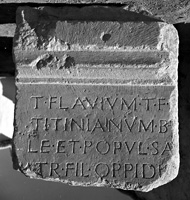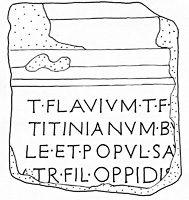 MAMA XI 343 (Savatra)
MAMA XI 343 (Savatra) 
Honorific base for T. Flavius Titinianus
- Type of monument:
- Honorific statue-base.
- Location:
- Yağlıbayat (Savatra): in a yard.
- Description:
- Greyish-white marble statue base, with moulding at top; broken above, right and below.
- Dimensions:
- Ht. 0.65+; W. 0.55+; Th. --; letters 0.040-0.045.
- Record:
- Line drawing; MB notebook copy; photograph (1956/199).
- Publication:
- None; mentioned by Mitchell 1977: 78; Mitchell 1993: I 67; I 96.
- Date:
- First or second century AD.
T(itum) · Flavium · T(iti) · f(ilium) ·
Titinianum · bụ-
le · et · populus · Saṿ-
ạtr(anorum) · fil(ium) · oppidi hed.
- - - - - - - - - -
The council and the people of the Savatreis (honoured) T(itus) Flavius Titinianus, son of T(itus), son of the town...





For the ethnic of Savatra in the Roman imperial period (Σαουατρεύς/Σαουαθρεύς), see Robert, Hellenica X, 73-4; 13, 43; Aulock 1976: 48-50, 73-5. For other public monuments of Savatra, see Cronin 1902: 371-2, no. 144 (IGR III 1481: Σ̣[α]ο̣υ̣α̣τ[ρέων ἡ βουλὴ καὶ ὁ δῆμος]); MAMA VIII 228 (Σαουατρέων ἡ βουλὴ καὶ ὁ δῆμος); MAMA VIII 231 ([Σα]ουα[τρέων ἡ β]ου[λὴ καὶ] ὁ δῆμος); MAMA VIII 232 (ὁ δῆμος). It is striking and unusual to find Latin being used for a public document produced by a Greek city: see Brélaz 2008.
Mitchell 1977: 78 (and Mitchell 1993: I 67 and 96) reports the name of the honorand as T. Flavius Titianus, and identifies him with the Hadrianic procurator of Galatia T. Flavius Titianus (Pflaum 1960-1: I 231-5, no. 99). Unless we assume an egregious mason’s error in line 2 (Titinianum for Titianum), this identification is untenable. The nomen Titinius and the cognomen Titinianus are relatively widespread in the Greek east (Salomies 2007: 70); in this region, see MAMA VII 110 (Ilgın: Titinia); Laminger-Pascher 1992: 149, no. 210 (Lystra: Titinius). A certain Flavius Marcellus is attested at Savatra in the late first or early second century AD as civic high-priest of the imperial cult and priest of the ancestral gods Ares and the Areiai (Cronin 1902: 371-2, no. 144; IGR III 1481; cf. Robert, Hellenica X, 76-7). The only other Latin inscriptions known from Savatra (apart from milestones) are a funerary monument for the primipilaris T. Servaeus Sabinus, set up by his son L. Servaeus Sabinus, centurion of legio VI Victrix (Cronin 1902: 372, no. 145; CIL III 14398), and a later posthumous statue-base for L. Servaeus Sabinus (Ramsay and Ramsay 1928: 188-90; AE 1930, 109).
The inscription seems to have been drafted by someone whose first language was Greek: note that the Greek term βουλή has been transliterated, not translated (senatus), and the common Greek honorific title υἱὸς τῆς πόλεως (Robert 1969: 316-21; Canali de Rossi 2007), which has no Latin equivalent, has been translated literally as fil(ium) oppidi. I know no precise parallel for this in Latin inscriptions, although in an unpublished inscription from the Roman colony of Philippi in Thrace, knowledge of which I owe to the kindness of Cédric Brélaz, a Roman eques by the name of C. Oppius Montanus carries the title fil(io) col(oniae). The title is more idiomatically translated by Apuleius, Metam. 4.26 as filius publicus (Robert 1969: 317 n.4).